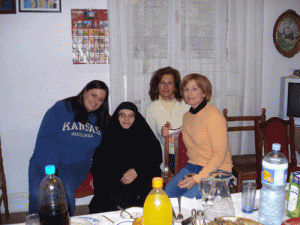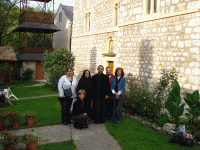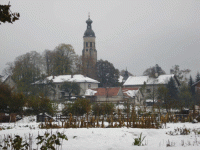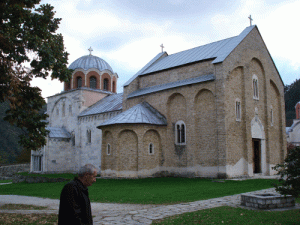News and Events - December 2007
JOURNEY OF A LIFETIME
We arrived in Belgrade, Serbia at 12:55 on October 16 after a very long flight from the United States. Our group included Father Alex, his sister Desanka, his nephew Philip, Bonnie Kuhn, Jodi Casey, Dan Fuller, and myself Christy Fuller. Once we arrived we found out the airline had lost one of Father Alex’s bags. The rest of us were very lucky.
From the airport we drove north to Novi Sad. On our way we drove over the Danube River. This is one of the longest rivers in Europe. I noticed that the countryside is flat like Kansas here and very fertile. Everywhere you looked you saw a farmer tilling the fields getting ready for winter. It was very pretty. Once in Novi Sad we found our hotel, Hotel Putnik. The driver took Father and Desanka to their Mother’s house. His Mother, Jelica Bugarin, lives about 6 miles west of Novi Sad. The rest of our little group connected with family members we had never met before. Bonnie and Jodi’s family, from the Momcilovic side, live in Novi Sad. My Dad and I’s family from the Uzelac side drove up from Belgrade to meet us. We all agreed that it was great to meet our different family members and we had a fantastic time talking to them.
We got up early the next day. The driver, his name was Blogoje Jovanovic, picked us up at the hotel. He took us to pick up Father Alex at his Mother’s house. While we were there his mother and sister fed us a breakfast of cheese “gibanica”, yogurt and chocolate torte. Father’s mother is a wonderful cook! After breakfast we went to our first Monastery of the trip. We went to Monastery Kovilj. St. Sava built this monastery in the 13th century. It was burned twice by the Turks and rebuilt in the 1800’s. Monks live there and care for the monastery along with a huge orchard and farm. We left the monastery and went to Gardinovci. This was the small village Father’s mother is from. This is also where Father Alex’s father had his first parish. We then went to Sremski Karlovci, Fruska Gora where we went to the Cathedral of St. Nicolas that had a western influence in its architecture. In front of this church is a little park. Children were everywhere. Father Alex said that in Serbia children only go to school half days. He said that sometimes the teachers of this town would bring their students to this park and teach them there. He also said all of the high schools in Serbia are vocational. This way when the children graduate they already have a job skill. For lunch we went to the Dunav Restaurant on the Danube River. Father Alex likes to go there for the fish soup. He says they are famous for it.
This day we traveled back thru Belgrade. We saw buildings there that had not been repaired yet from the bombings in 1999. Here we visited the St. Sava Cathedral that had begun construction in 1935 but had stopped because of WWII. The government returned the property to the Serbs and construction continued in 1985. Words cannot describe how big it is. Although it is not finished yet, we were able to go inside and take a look around. The entire building is made of marble. Walking into the church was very humbling because of the size. It makes you realize how small you really are. As we were leaving the bells rang. There are approximately 150 bells in this monastery. We all felt chills listening to them ring throughout the square in front of the church. A statue of Karadjordje is in front of the cathedral. He was the leader of the Serbian uprising against the Turks in 1804. After visiting St. Sava Cathedral we went to Pokajnica Monastery. This church was built out of logs in 1818. The nuns that live there have planted a wonderful garden full of flowers. It was a gardener’s dream! We met the abbess and she invited us for coffee and “ratluk” with her. On the way out we saw a nun driving a tractor while tending to her chores. We could always tell if nuns resided in the monastery by the flowers. They have a natural green thumb.
We then went to Ravanica Monastery to stay the night. This monastery was built in the 1300’s. They have the relics (moshti) of St. Lazar of Kosovo. A piece of his relic is in the altar table at St. George’s Church in Lenexa where they were placed during the church consecration in 2006. After the morning service we left and went to the town of Krushevac where we saw the church of Lazarica. This was the first church St. Lazar built. It was very small and was built in the 1300’s. Our next monastery was Ljubostonja near Trestenik. Widows of the Kosovo war started this monastery in 1389. We had coffee with the abbess and bought some grape brandy and wine they made at the monastery. We also ran into Jovan Vejnovic, the artist who carved the iconostases in St. George Church in Lenexa. We then drove to Vrnjcaka Banja. We did some shopping there and took a picture with the world’s largest “opanka” – peasant shoe. It must have been 8 feet long. This area is famous for their wonderful spas. After dinner we drove to Zicha Monastery to spend the night. Zicha was built in 1207 and the Bishop calls this monastery his home. There were 7 different Serbian kings crowned here throughout the years. Whenever a new king was crowned they would build a new door to enter the church. Zicha was also bombed by the Nazi’s in WWII so most of it has been rebuilt. The exterior is a brilliant red. It is beautiful. We woke up at 6:00 to attend the 7:00 Liturgy. The service was beautiful! After the Liturgy we had coffee and breakfast with Abbess Mati Jelena. She gave us a small bag of presents before we left. Each bag contained an icon of Jesus, a prayer rope bracelet, incense, and information on the church.
We then drove to Studenica Monastery. To get there we drove thru the mountains. They were stunning to look at! St. Simien built this church in the 1100’s. He was the father of St. Sava. His grave with relics was inside the monastery along with his wife, Anastasia, and son St. Stevan Prvovenchani. The frescos were being refurbished while we were there. According to our guide the church had damaged the original frescos by painting over them in the 1700’s because they wanted new frescos. Then in the 1800’s the church hired someone to come in and clean the frescos and they found the original frescos underneath. These original frescos were somewhat damaged. The famous fresco of Jesus Christ crucifixion was in that church. They had a lounge where we had tea made from berries they grew there. We left and ate lunch at one of the little town’s we drove through.
Monastery Nikolje was our last stop of the day. The church there was built in the 1300’s. They had just taken out the ikonostas to have it worked on. According to one of the nuns termites had started to destroy the icons. They invited us in for slivovica, “slatko” and coffee. Father Alex served vespers, we ate a dinner of soup, cheese gibanica, wine, pork and tomatoes. It was unusual to have meat at a monastery but the pork had been left over from lunch they had served to some outside workers. The nuns were very, very nice there especially one nun named mati Aleksandra. We had a great time trying to communicate with her and the abbess. Thank goodness I had brought my Serbian phrasebook! By the end of our stay mati Aleksandra had a special place in all of our hearts. We agreed to learn the Serbian language and she agreed to learn English. And believe me she is a woman of her word.
In the morning we left for Plaski, Croatia. Along the way we went to Topola - Oplenac. Located there is a mausoleum that King Peter I built for the Serbian Royal Family Karadjordjevich. This mausoleum was unbelievable. It is covered in frescos that are made from mosaic tile. We were told that it took 60 million pieces of tile in 15,000 different colors to make all of the frescos.
It was a long drive to Plaski so we did not get there until well after midnight. Each of us stayed with a different hostess. They were all very nice and made us feel very welcome. Jodi stayed with Djurdja Petrovic (nee Jovetic), a relative of the Budimlijas, Sumonjas and John Harmon - Jovetic. Bonnie stayed with Nena Visnjic, who ended up being a relative of hers from the Vukas family. Dan stayed with Dushanka Sarcevic and her husband who were relatives of the Gerba family. I stayed with Milica Kraguljac and her family.
Our first morning in Croatia we woke up to snow and lots of it. The snow didn’t seem to slow anyone down. You still saw people riding their bikes for transportation or walking. We drove through some of the sub-villages of Plaski to see some of Jodi and Bonnie’s relatives from the Vukas family in Jezero. We stopped by two different relatives’ homes. One of them was making their own saur kraut. We also picked up their cousin Anka Miscevic in the town of Josipdol. Anka’s dad and + Sava Vukas were brother and sister, which makes Anka a cousin of Louise Draskovich and our late + Bessie Sachen and + Dorothy Radojevich. We drove back to Plaski and went to church at St. Mary’s that had once been a cathedral. In 1941 Croatian Nazi’s killed a Bishop and 8 priests there. Father had planned a memorial service for all of the Serbs from that Plaski that had moved to Kansas City. It was very moving. The church was pretty but needed a lot of work. The women of Plaski threw us a welcoming party. They had cooked all of the ethnic foods from that region. The food was wonderful! They also sang us songs and taught Jodi, Bonnie, and I some dances. We had a lot of fun with them.
Our last day in Croatia we drove to Medak to see Nikola Mihic. He is my Dad and I’s cousin. We drove thru a mountain range to get there and it was very picturesque. We spent some time at Nikola’s house. They served a lunch of delicious pork, pickled peppers, bread and drink. Nikola played the tambura then took us to the old homestead - Pocitelj where the Uzelac’s came from. We had to stay off the roadside to keep away from land mines left from the war.
We started the drive back to Plaski later that afternoon. On the way we stopped at the Nikola Tesla Museum in Smiljan near Gospic. The next morning we said our goodbyes to our hosts and drove back to Belgrade. From there we all went our separate ways. Father Alex, Bonnie, and Jodi went back to Novi Sad to spend one more day with their families. My Dad and I stayed in Belgrade to meet the rest of our relatives.
This was quite a learning experience for all of us. I think going back to the old country and learning more about our heritage makes us understand ourselves a whole lot better. For instance Bonnie, Jodi, and I were talking one evening of how when company comes to our house there is always food and drink ready. That is also how it is in Serbia and Lika. Everyone there makes you feel very welcome and as if you are part of their family. We made a lifetime of memories in 10 days and we will never forget them. Thank you Father Alex for organizing such a fabulous adventure.
Submitted by Christy Fuller and Jodi Casey



